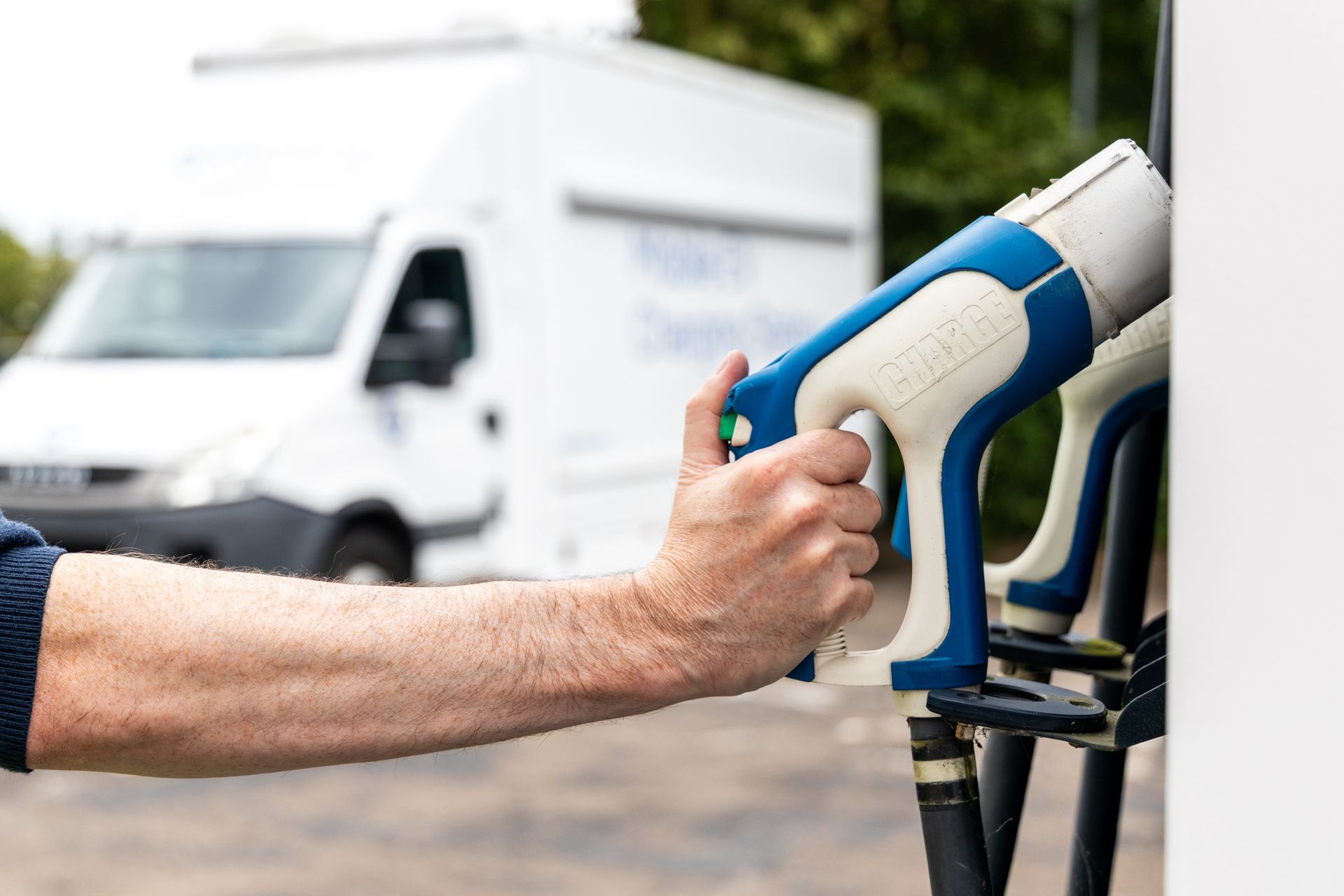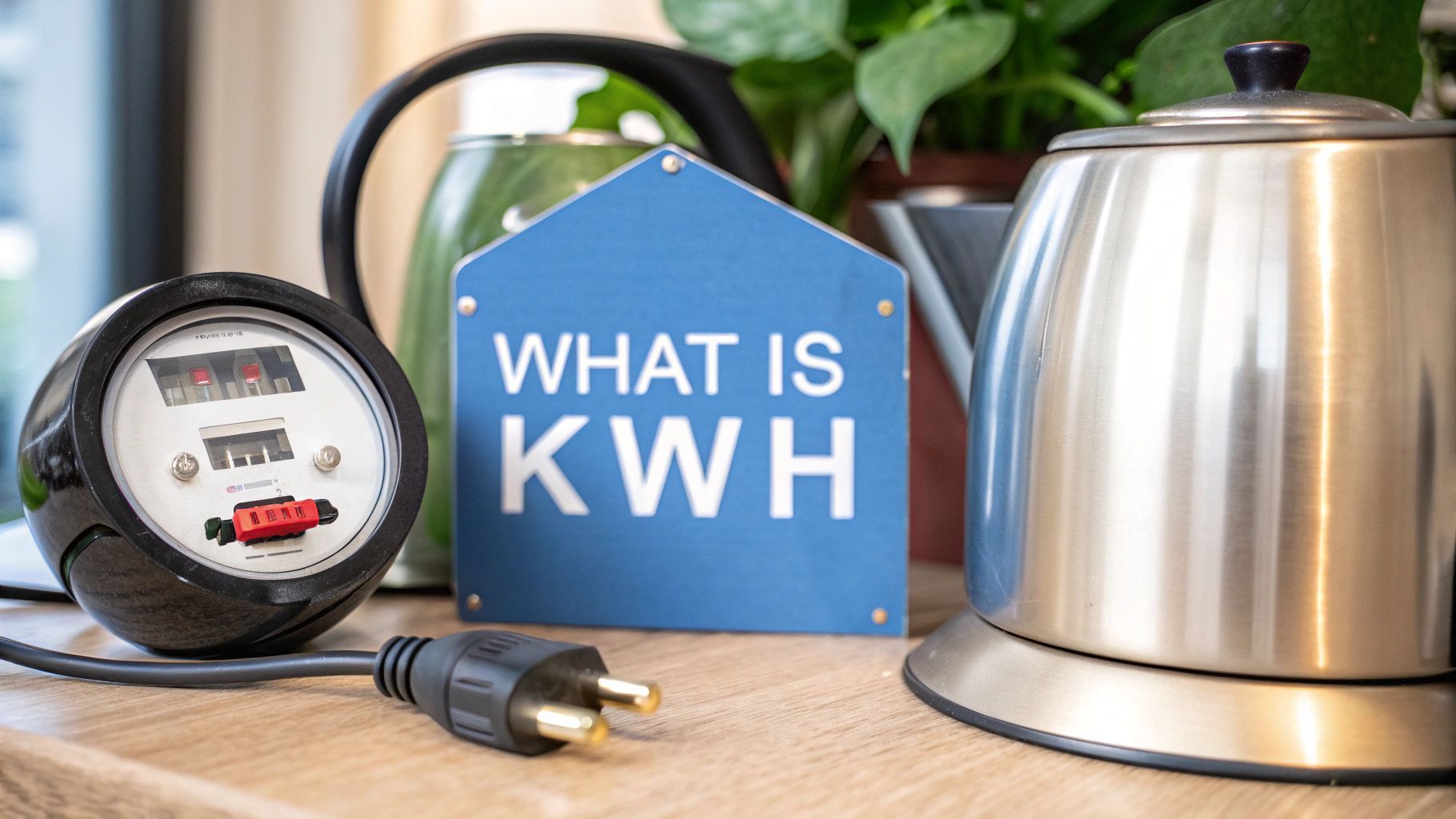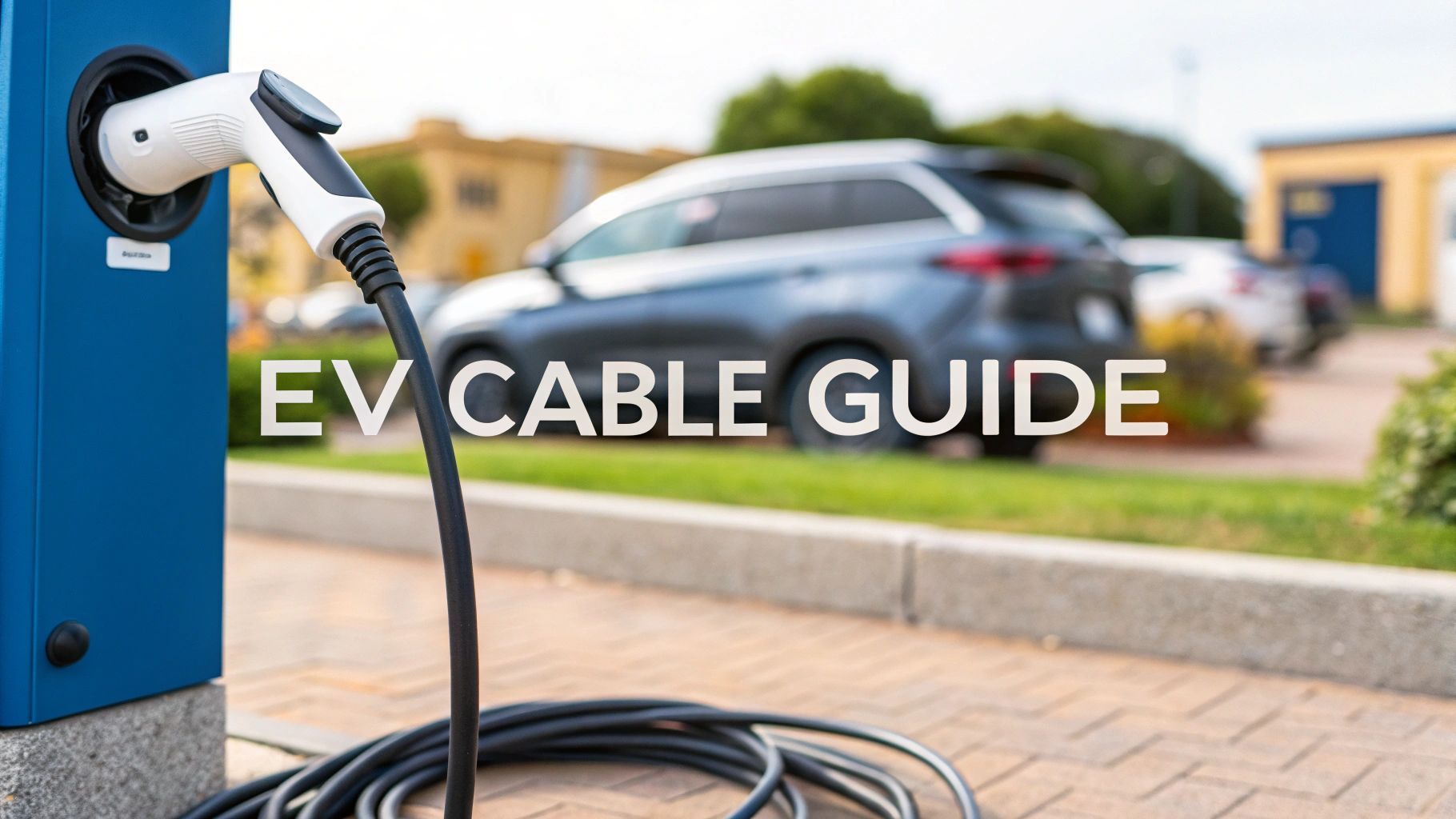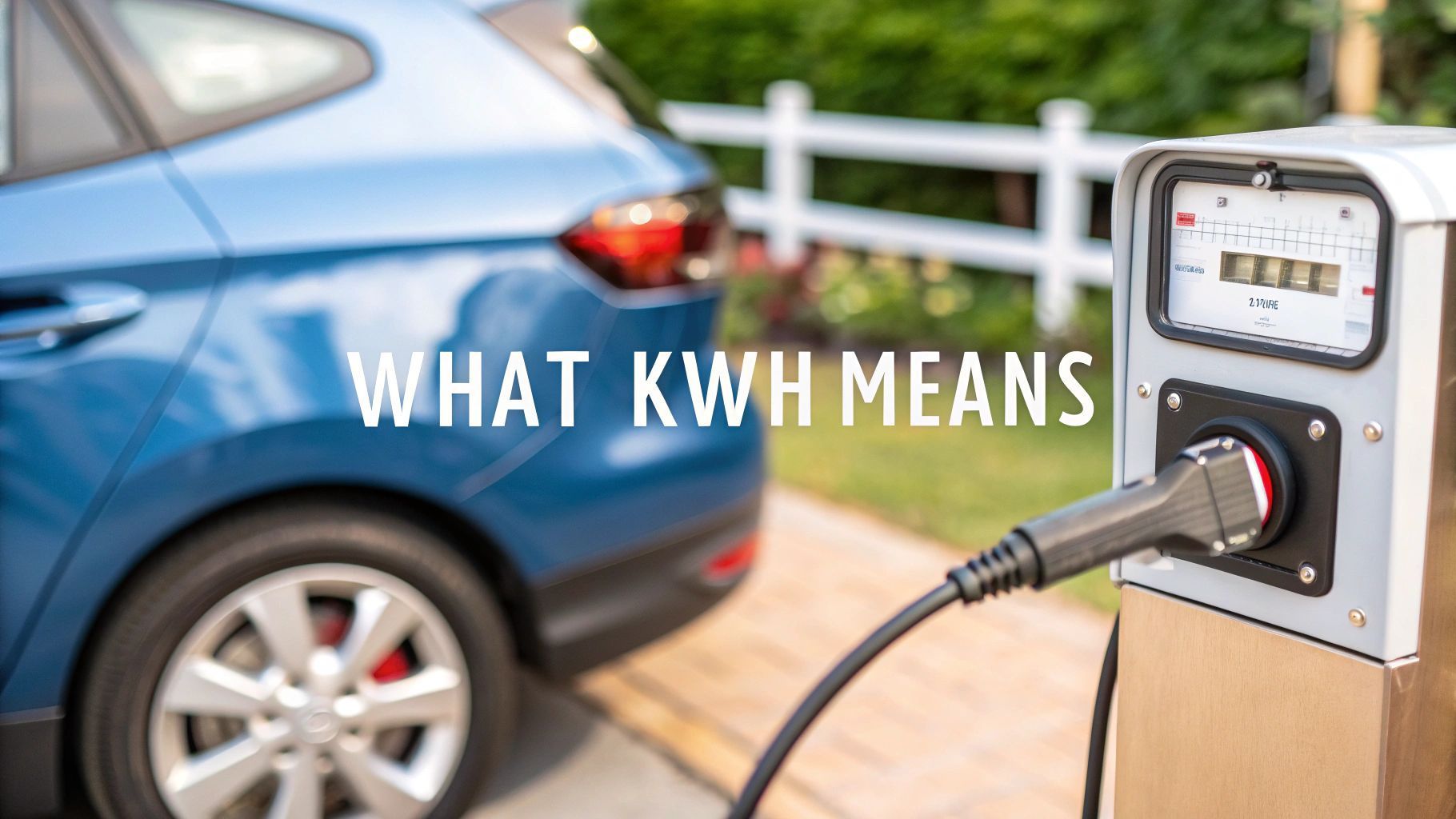What Is Kilowatt Hours? Understand How They Impact Costs
Staring at an electricity bill can often feel like trying to decipher a secret code. But once you understand one key term, everything starts to click into place. That term is the kilowatt-hour (kWh) and it's simply the standard unit of energy your supplier uses to measure your electricity consumption. In short, it’s the metric that decides what you pay.
Demystifying the Kilowatt-Hour, Without the Jargon
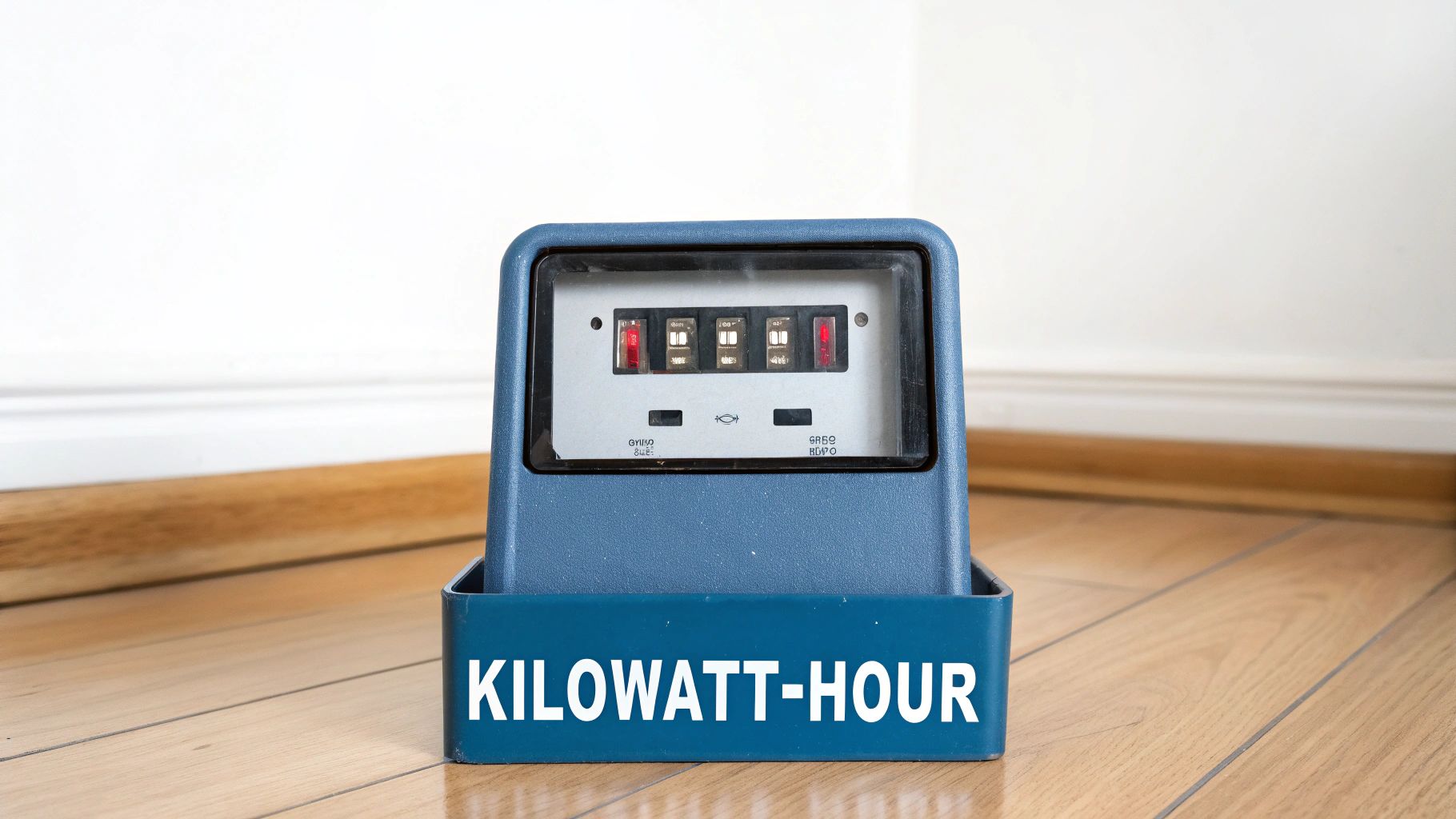
To really get your head around what a kilowatt-hour is , let's ditch the technical talk and use a simple analogy. Think of electricity as water flowing from a tap.
The speed at which that water flows is like power , measured in kilowatts (kW) . A powerful tap gushes out more water every second, just like a high-power appliance pulls more electricity from the grid at any given moment.
A kilowatt-hour (kWh) , on the other hand, is the total amount of water you've collected in a bucket over a set period. It’s not about the speed of the flow; it’s about the total volume collected. Your energy bill doesn't charge you for how fast you use electricity (kW) but for the total amount you've used over the month (kWh).
Connecting kWh to Everyday Life
This all becomes much clearer when you apply it to the appliances in your home. One kilowatt-hour is the energy needed to run a 1,000-watt appliance for a full hour. So, a 1,000-watt microwave running for exactly one hour would use precisely one kWh.
Let’s look at a few other common examples:
- Boiling a Kettle: A typical 2,000-watt (2 kW) kettle takes about three minutes to boil. That works out to roughly 0.1 kWh of energy used.
- Watching Television: A modern LED TV might only use around 100 watts . Watching it for ten hours would consume one kWh.
- Charging an EV: This is where understanding kWh becomes absolutely essential. A standard 7 kW home charger running for one hour will add 7 kWh of energy to your car's battery.
A kilowatt (kW) measures power —the rate of energy use at one specific moment. A kilowatt-hour (kWh) measures energy —the total amount of power used over a period of time. This is the fundamental difference that appears on your bill.
For anyone diving into the world of electric vehicles, getting these terms straight is non-negotiable. If you want to explore more definitions, our comprehensive EV charging glossary can help you become fluent in the language of electric power. Grasping what a kilowatt-hour is empowers you to understand your energy consumption, control your costs and make smarter decisions about everything from your household appliances to your vehicle.
From kWh to Pounds Sterling: Decoding Your Energy Bill
Seeing the numbers tick over on your electricity meter is one thing but connecting them to the final figure on your bill is where the real power lies. Energy suppliers use a simple bit of maths to work out what you owe: they just multiply the total kilowatt-hours (kWh) you’ve used by their price per unit.
This price, often called the unit rate, is what turns an abstract number into a real-world cost in pounds and pence. For instance, if your home used 250 kWh in a month and your supplier’s rate is 25 pence per kWh , your bill for that energy comes to £62.50 (that’s just 250 x £0.25). Of course, that’s before they add any daily standing charges.
So, Is Your Household a Big Energy User?
To get a feel for whether your energy use is high or low, it’s useful to see how you stack up against the national averages. In the UK, the size of your household is one of the biggest factors determining how much electricity you typically get through. The key measure here is the kilowatt-hour (kWh) – the energy needed to run a 1,000-watt appliance for one hour.
According to Ofgem's figures, the average UK household with 3-4 people gets through around 2,700 kWh per year . That works out to about 225 kWh a month, or roughly 7.5 kWh each day.
Knowing where you stand can shine a light on some clear opportunities to save money. If you find your usage is miles higher than the average for a home your size, it could be a sign of inefficient appliances or just habits that could do with a tweak.
Your energy bill is a direct reflection of your consumption habits. By understanding how kilowatt-hours translate into costs, you transform a simple metric into a powerful tool for household budgeting and financial planning.
Average UK Annual Electricity Use by Household Size
- Low Consumption (1-2 people): Typically uses around 1,800 kWh per year. This often applies to flats or smaller homes with fewer high-power appliances in regular use.
- Medium Consumption (3-4 people): The national benchmark, averaging approximately 2,700 kWh annually. This reflects a standard family home with typical appliance usage.
- High Consumption (5+ people): Can easily exceed 4,100 kWh per year. Larger families in bigger homes naturally consume more energy for heating, cooking and entertainment.
By digging out your old bills and comparing your kWh figure to these benchmarks, you can get a much clearer picture of your energy footprint. If you’re looking to bring those numbers down, exploring a Smart Home Energy Management: My Ultimate Guide can give you the insights and tools to start optimising. That knowledge is what empowers you to make smarter decisions and unlock some serious savings.
Calculating Energy Use for Appliances and Electric Vehicles
Now that we can connect kilowatt-hours to what you actually pay on your bill, let's put that knowledge to good use. Figuring out your energy consumption is surprisingly simple once you know the basic formula and it works for everything from your kettle to your car.
The calculation is pretty straightforward.
(Appliance Wattage ÷ 1,000) x Hours Used = kWh Consumed
Let's see this in action with a couple of common household items. A powerful 2,000-watt kettle that boils in three minutes (or 0.05 hours) will use 0.1 kWh . Meanwhile, a modern 50-watt television running for four hours uses 0.2 kWh . It’s this simple maths that unlocks a real understanding of your energy footprint.
This infographic is a great way to visualise the difference between kilowatts (kW) – the rate of energy flow – and kilowatt-hours (kWh), which is the total amount you use over time.
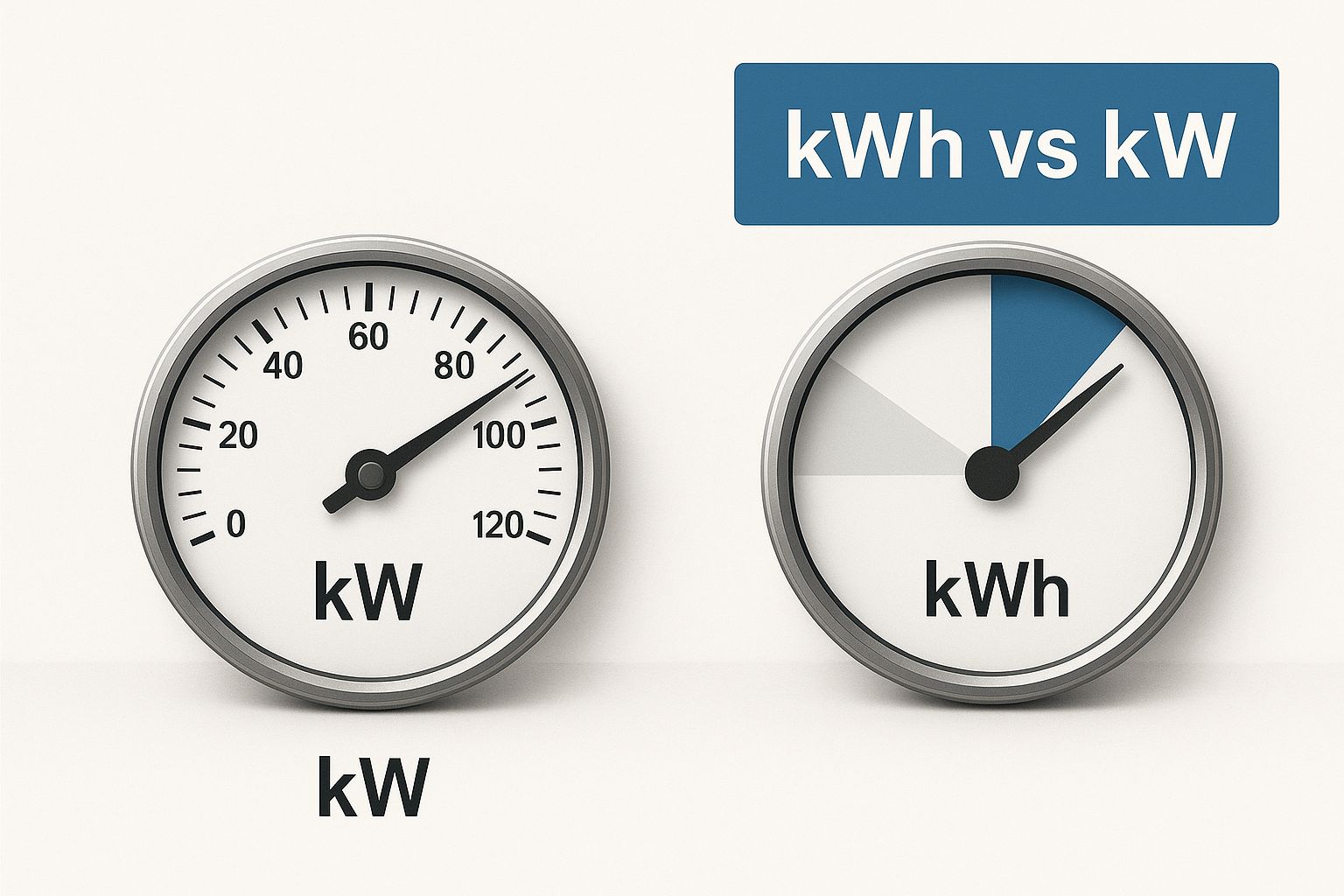
As the gauges show, kW is an instant measure of power demand, a bit like the speed you're driving. In contrast, kWh is the total energy consumed over a period, like the total distance you've travelled. It's the kWh figure that ultimately shows up on your electricity bill.
To put this into a clearer perspective, here’s a look at what some common appliances and EV chargers consume.
Estimated kWh Consumption of Common Household Items
The table below breaks down the typical power ratings of various devices and shows how much energy they would use if run for a full hour. This helps illustrate how different items contribute to your overall energy bill.
| Appliance / Device | Typical Power Rating (Watts) | Energy Used in One Hour (kWh) |
|---|---|---|
| LED Light Bulb | 10 W | 0.01 kWh |
| Laptop | 60 W | 0.06 kWh |
| Television (55-inch LED) | 100 W | 0.1 kWh |
| Fridge Freezer | 200 W | 0.2 kWh |
| Washing Machine | 2,000 W | 2.0 kWh |
| Tumble Dryer | 2,500 W | 2.5 kWh |
| Standard EV Charger (Level 2) | 7,000 W | 7.0 kWh |
| Rapid EV Charger | 50,000 W | 50.0 kWh |
As you can see, high-power items like a tumble dryer or an EV charger consume significantly more energy per hour than smaller electronics. This is why understanding kWh is so vital for managing costs, especially when it comes to charging an electric vehicle.
Applying kWh to Electric Vehicle Charging
When you own an electric vehicle, grasping kilowatt-hours becomes absolutely essential for managing your running costs. The same formula applies, just on a much bigger scale. An EV with a 60 kWh battery, for instance, needs 60 kilowatt-hours of energy to go from empty to a full charge.
If you’re charging at home with a standard 7 kW wall box, you can easily estimate the time it will take. Just divide the battery size by the charger’s power: 60 kWh ÷ 7 kW = roughly 8.5 hours .
Calculating the cost is just as simple. If your electricity tariff is 25p per kWh , a full charge works out to be 60 kWh x £0.25 = £15.00 . That’s a fraction of what it would cost to fill a similar-sized petrol car, highlighting one of the biggest benefits of going electric. To learn more about the technology inside an EV, you can explore our guide to battery packs for car charging in the UK.
Home vs Public Charging Costs
The price difference between charging at home and using public stations really brings the importance of kWh into focus. While home charging typically costs between 20p and 30p per kWh , public rapid chargers are often much more expensive, sometimes running from 60p to 80p per kWh . This higher price covers the cost of installation, grid connection and ongoing maintenance.
This means the same 60 kWh charge that costs £15.00 at home could set you back as much as £48.00 at a public rapid charging station. Of course, while managing energy use is key, so is safety. This helpful guide to electric vehicle fire safety offers some valuable insights into potential risks.
By understanding kWh, you can make smarter decisions about where and when you charge, keeping your running costs firmly under control.
The Business of Mobile EV Charging
The rise of the EV has introduced a very modern problem: 'charge anxiety'. It’s that nagging worry every EV driver has felt about finding their next charge point before the battery hits zero. This is exactly where mobile charging services come in, turning the humble kilowatt-hour into a profitable, on-demand business. By bringing the power directly to the customer, you’re not just selling electricity; you’re selling pure convenience.
Turning Kilowatt-Hours Into Profit
The business model for mobile EV charging is refreshingly simple yet incredibly effective. At its core, an operator buys electricity at a standard rate, stores it in a portable charging unit and then sells those kilowatt-hours to a customer at a premium. That premium isn't just for the electricity—it’s for the convenience of a roadside rescue or a top-up at their workplace.
Let's break down the basic costs. An operator might charge their mobile power bank at home overnight, taking advantage of an off-peak rate of, say, 15p per kWh . If they deliver a 20 kWh top-up to a stranded driver, their direct cost for the energy is a mere £3.00 .
Of course, the customer isn't just paying for the electrons. They're paying to solve a problem right now. They’re avoiding a long wait at a public charger or perhaps even dodging the hefty cost of a tow truck. For that level of service, charging a price of £1.00 per kWh plus a call-out fee is perfectly reasonable.
The core value proposition of mobile charging is convenience. Customers are willing to pay a premium for a service that saves them time and eliminates the stress of finding a fixed charging station, turning a simple kilowatt-hour into a high-margin product.
This business model works so well because it has some clear advantages over the traditional approach of building fixed charging infrastructure.
The Advantages of a Mobile Operation
One of the biggest benefits of running a mobile charging service is the dramatically lower overhead. There are no expensive groundworks to fund, no planning permission battles to fight and no long-term leases on a physical site to worry about. The main investment is the mobile charging unit itself and a vehicle to get it where it needs to go.
This lean approach gives you incredible market flexibility. An operator can go wherever the demand is, targeting different areas or events based on real-time opportunities as they arise.
- Targeting High-Demand Areas: You can position yourself near shopping centres, business parks or tourist attractions where charging demand is high but infrastructure is still catching up.
- Servicing Vehicle Fleets: A mobile unit can provide on-site charging for commercial fleets of delivery vans or taxis, offering a valuable and reliable business-to-business service.
- Event-Based Opportunities: Music festivals, outdoor markets and sporting events create temporary hotspots of high EV density, giving you a captive audience for mobile charging.
Calculating Your Potential Earnings
Let's walk through a realistic scenario to see how the profits could look. Imagine an operator completes five mobile charges in a single day, delivering an average of 25 kWh to each customer.
If we assume a cost of £0.15 per kWh to fill the mobile unit and a selling price of £1.00 per kWh plus a £20 service fee per call-out, the numbers start to look very attractive.
- Total Energy Delivered: 5 charges x 25 kWh = 125 kWh
- Total Revenue: (125 kWh x £1.00) + (5 x £20 service fee) = £225
- Total Energy Cost: 125 kWh x £0.15 = £18.75
- Gross Profit Per Day: £225 - £18.75 = £206.25
Even after you factor in fuel for the vehicle and other day-to-day running costs, the profit margins are compelling. Scale that up over a month and it’s clear how a solid grasp of the kilowatt-hour can be the foundation of a successful business. For a more detailed breakdown, explore our deep dive into the economics of mobile EV charging. This model effectively transforms electricity from a utility cost into a lucrative, on-demand service.
Understanding Your Place in the UK Energy Market
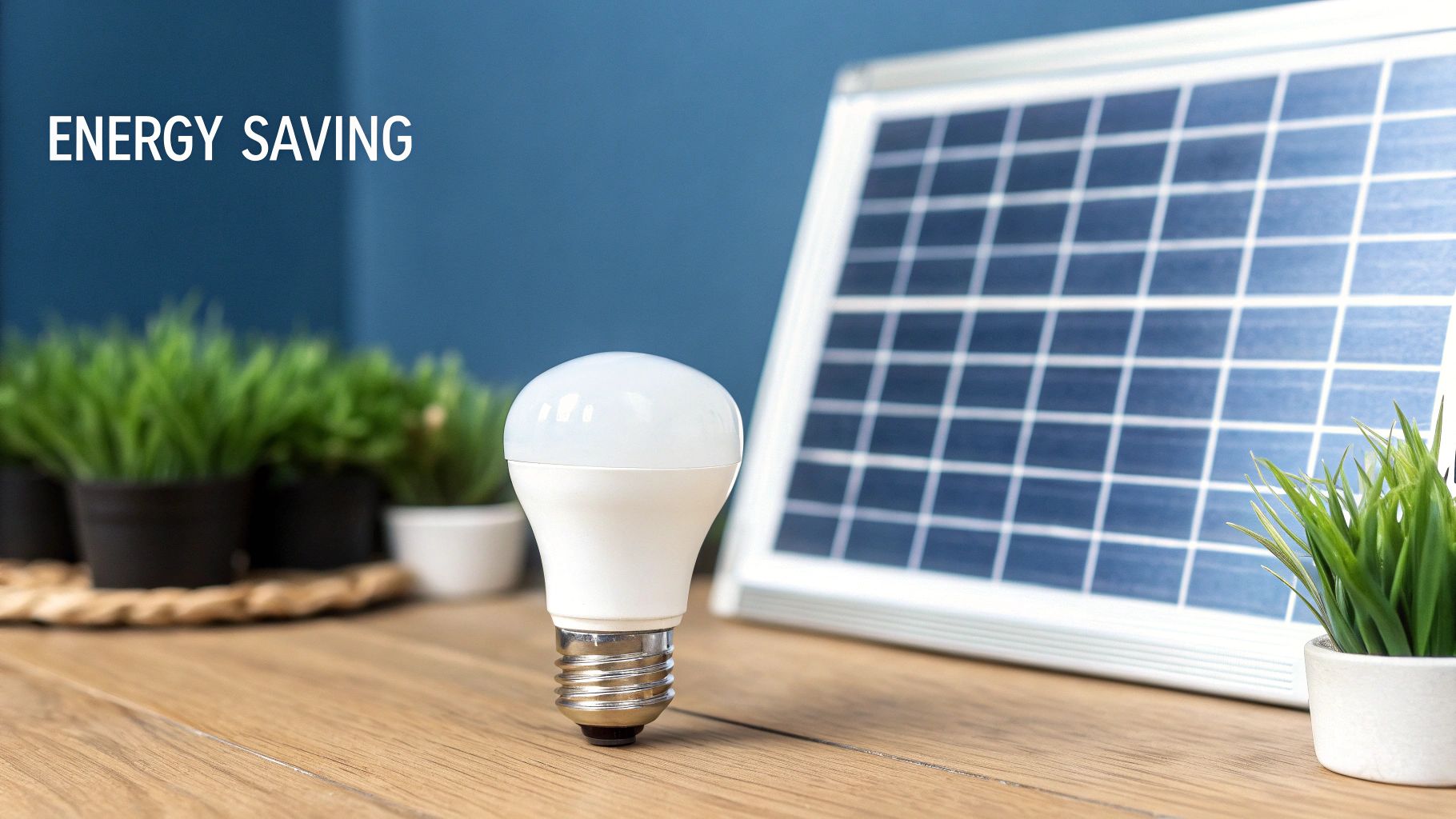
To really get a feel for what a kilowatt-hour means, it helps to zoom out and look at the bigger picture. Your own energy use is part of a much larger, and frankly fascinating, national story here in the UK. And that story is full of some surprising twists and turns.
Believe it or not, over the last two decades, the UK's total electricity demand has actually dropped. This is mostly down to huge leaps in energy efficiency – everything from our light bulbs to our factories has become far less power-hungry. We've seen total demand fall from a peak of 357 terawatt-hours in 2005 to around 318.65 terawatt-hours in 2024 . You can explore more data on UK energy trends and see the impact for yourself.
But here’s the interesting part: while the country as a whole is using less, our homes are quietly bucking that trend. With more gadgets, home offices and of course, electric vehicles, the energy we use at home is growing. In fact, households accounted for roughly 100 terawatt-hours in 2022 alone, making how we manage our personal energy more important than ever.
The UK's Shift Towards Cleaner Energy
Running alongside these changes in demand is a fundamental shift in where our electricity comes from. The UK has made massive strides in moving away from fossil fuels, especially coal and has wholeheartedly embraced renewable energy. This isn't just a policy ambition; it's a reality that's completely reshaping our national grid.
This national pivot towards sustainability gives every kilowatt-hour you use a new layer of meaning. Your choices are no longer just about the monthly bill. They're about your part in a larger, cleaner energy system.
Each kilowatt-hour consumed at home is part of a complex national picture. By understanding the broader trends in UK energy, you can see how individual choices to manage consumption or support mobile charging contribute to wider sustainability and grid stability goals.
How Your Kilowatt-Hours Contribute
Every decision you make about your energy use has a ripple effect. Whether it's charging your EV during off-peak hours or investing in energy-saving appliances, you're helping to reduce the strain on the national grid.
This is especially true for mobile EV charging operators. When you provide on-demand power, you’re not just running a business – you’re actively supporting the grid. You offer a flexible solution that can help manage local demand, particularly in places where fixed charging points are still thin on the ground.
Your kilowatt-hours become part of the solution, helping to build a more resilient and sustainable energy future for everyone in the UK.
Common Questions About Kilowatt-Hours
Once you’ve got a handle on what a kilowatt-hour is, a few practical questions usually follow. Let's run through the most common ones to really cement your understanding and turn theory into practical knowledge.
What Is the Difference Between a Kilowatt and a Kilowatt-Hour?
This is easily the most frequent point of confusion but the distinction is actually quite simple when you think about it in terms of driving a car.
- A kilowatt (kW) is a measure of power . It tells you how much electricity is being used at a single moment. Think of it like your car’s speedometer – it shows your speed right now.
- A kilowatt-hour (kWh) is a measure of energy . It’s the total amount of electricity used over a period of time. This is like your car’s odometer – it shows the total distance you’ve travelled.
Your energy supplier bills you for the total distance you've travelled (kWh), not your top speed (kW).
How Can I Reduce My Household's kWh Consumption?
Cutting down your home’s kWh consumption is the most direct route to a smaller energy bill. The trick is to focus on the big-ticket appliances and build better energy habits.
Simple, consistent changes are what really move the needle on lowering your kWh usage. By focusing on energy efficiency and being a bit more mindful, you can make a noticeable dent in your annual energy bill.
A few effective strategies include:
- Switch to Energy-Efficient Appliances: When you're buying something new, always check for a high energy efficiency rating. These devices use far fewer kilowatt-hours to do the same job.
- Turn Off Electronics: Don't just leave things on standby. Unplugging devices or switching them off at the wall stops them from drawing "vampire power," which can add a surprising amount to your bill over a year.
- Improve Your Home's Insulation: Better insulation in your loft and walls means your heating system doesn't have to work nearly as hard to keep your home warm. That’s a direct reduction in kWh usage, especially during winter.
Why Does the Price per kWh Change?
The price you pay for each kilowatt-hour isn’t set in stone; it can and does fluctuate for a few key reasons. These include the wholesale cost of generating electricity, the fees for maintaining the national grid and various government policies or environmental levies.
Energy suppliers adjust their rates to reflect these background costs. In the UK, the energy regulator Ofgem sets an energy price cap, which limits the maximum unit rate a supplier can charge a typical household, giving you a degree of protection against sudden, sharp price hikes.
How Much Electricity Does the Average Person Use?
It’s always useful to have a benchmark to see how your own energy bills stack up. Back in 2022 , the average electricity consumption per person in the UK was around 4,813 kWh for the year.
Interestingly, this figure has actually dropped by about 30% over the last two decades. That’s largely down to huge improvements in appliance efficiency and shifts in industrial activity. You can read more about UK electricity consumption trends to see the bigger picture.
As the electric vehicle market continues to expand, understanding the kilowatt-hour is more important than ever. Whether you're trying to manage household costs or grow a business, ZAPME offers pioneering mobile charging solutions to put that power exactly where you need it most. Discover our range of portable EV chargers at https://www.zapme.biz.

